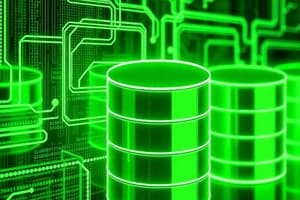Podcast
Questions and Answers
What prompted the development of database systems?
What prompted the development of database systems?
Difficulties with file-based applications in the 1960s and 1970s
What is one of the major purposes of a database system?
What is one of the major purposes of a database system?
- To provide users with an abstract view of the data (correct)
- To simplify file-based applications
- To eliminate the need for data relationships
- To provide users with direct access to physical storage
Which of the following is a type of data model?
Which of the following is a type of data model?
- Relational Model
- Entity-Relationship Model
- Semi-structured Data Model
- All of the above (correct)
What do tables in the relational model represent?
What do tables in the relational model represent?
The entity-relationship model is based on basic objects called relations.
The entity-relationship model is based on basic objects called relations.
Which programming languages are commonly associated with object-based data models?
Which programming languages are commonly associated with object-based data models?
Each table in the relational model contains records of a particular type known as ______.
Each table in the relational model contains records of a particular type known as ______.
Flashcards are hidden until you start studying
Study Notes
Database Systems Evolution
- Database systems were developed in the 1960s and 1970s to solve the problems associated with file-based applications.
- File-based applications were unreliable, had data redundancy, and lacked data integrity.
Data Models
- Data models are used to describe data, relationships between data, semantics, and consistency constraints.
- Different data models exist, classified into four categories: Relational, Entity-Relationship, Semi-structured, and Object-Based.
Relational Model
- The relational model uses tables to represent data and their relationships.
- Each table has columns with unique names.
- Each row in a table represents a single piece of information.
- The relational model is the most widely used data model.
Entity-Relationship Model
- The entity-relationship (E-R) model uses entities and relationships between them to represent data.
- An entity is a distinguishable object or thing in the real world.
- This model is used frequently in database design.
Semi-structured Data Model
- This model allows individual data items of the same type to have different sets of attributes.
- This contrasts with other models where every data item of the same type has the same attributes.
- JSON and XML are widely used representations for semi-structured data.
Object-Based Data Model
- Object-oriented programming (OOP) languages like Java, C++, and C# have integrated object-based concepts into database systems.
- Database systems allow storing procedures to be executed by the database system.
- This extends the relational model with ideas like encapsulation, methods, and object identity.
Relational Model Example
- A university database can be represented with tables, such as an "instructor" table holding details about instructors (ID, Name, Department, Salary) and a "department" table holding details about departments (Dept Name, Building, Budget).
- The "instructor" table would show, for example, that an instructor named Einstein with ID 22222 works in the Physics department and earns $95,000 annually.
- The "department" table would show, for example, that the Biology department is located in the Watson building and has a budget of $90,000.
Studying That Suits You
Use AI to generate personalized quizzes and flashcards to suit your learning preferences.




